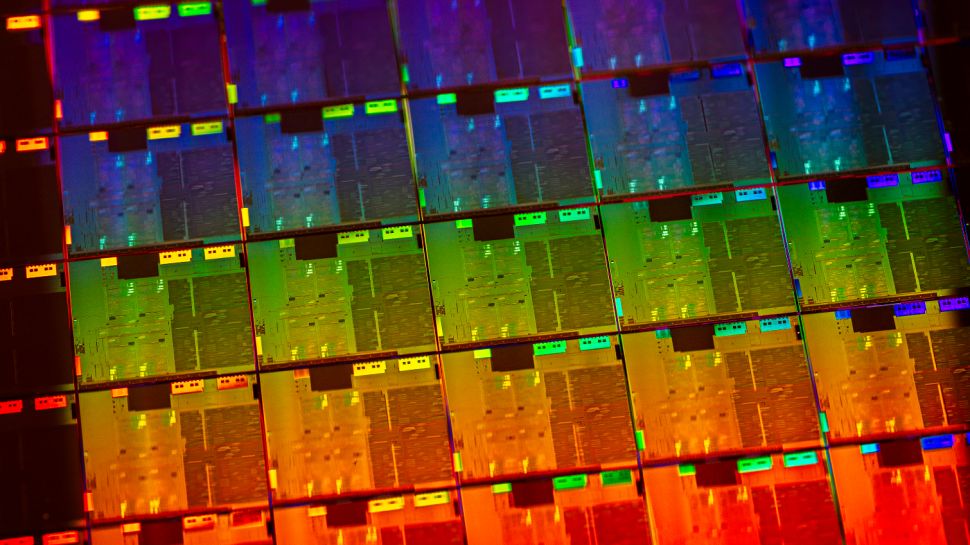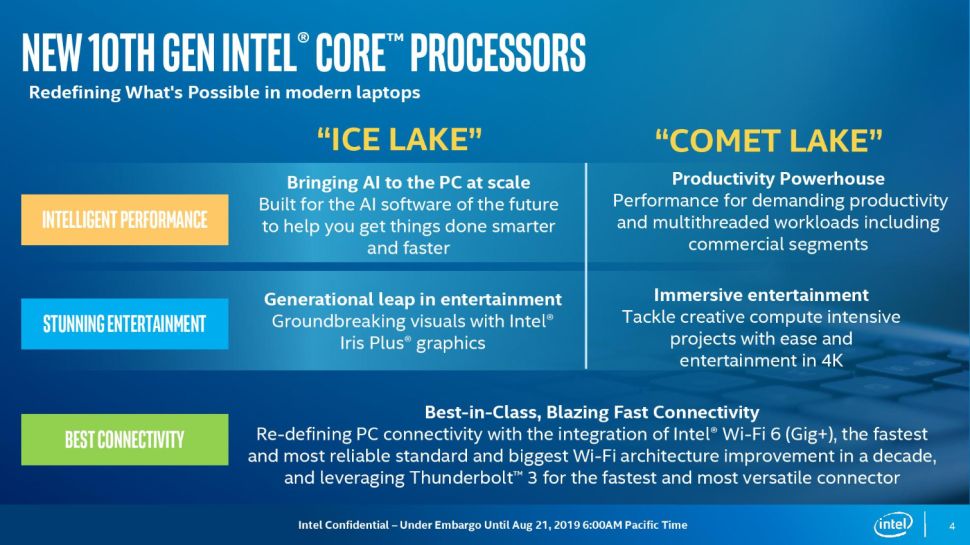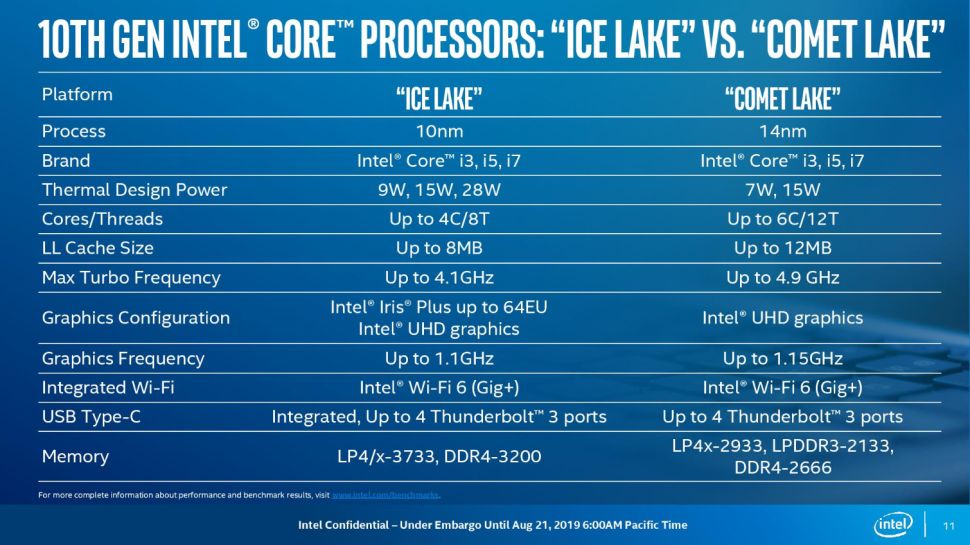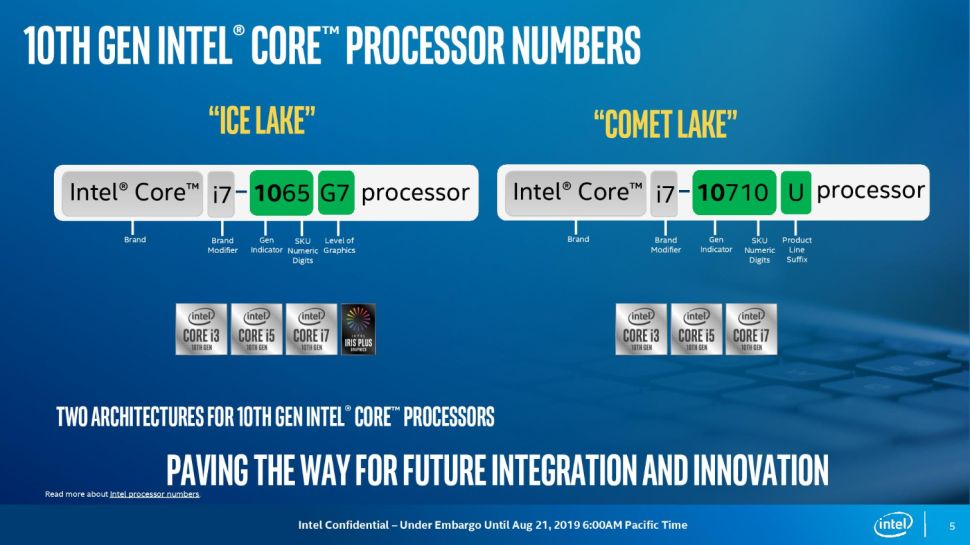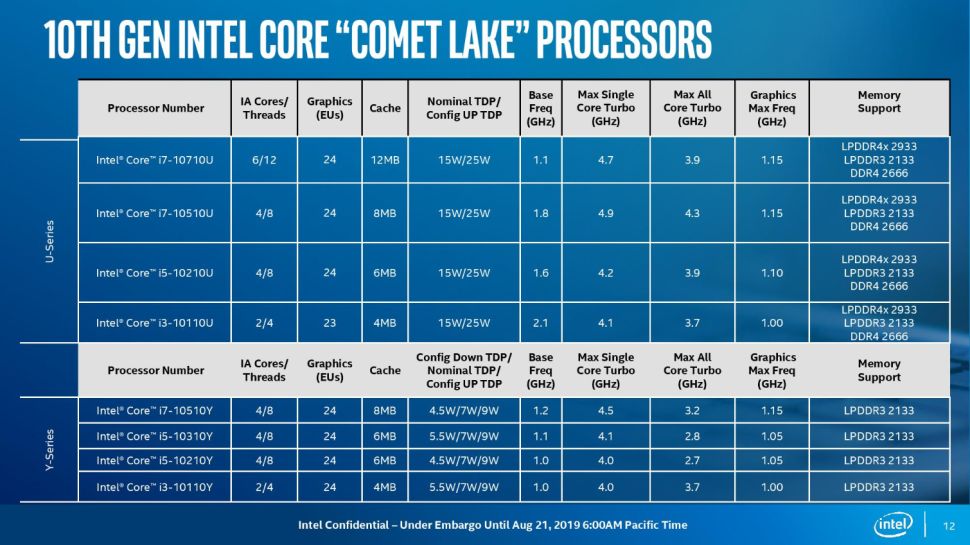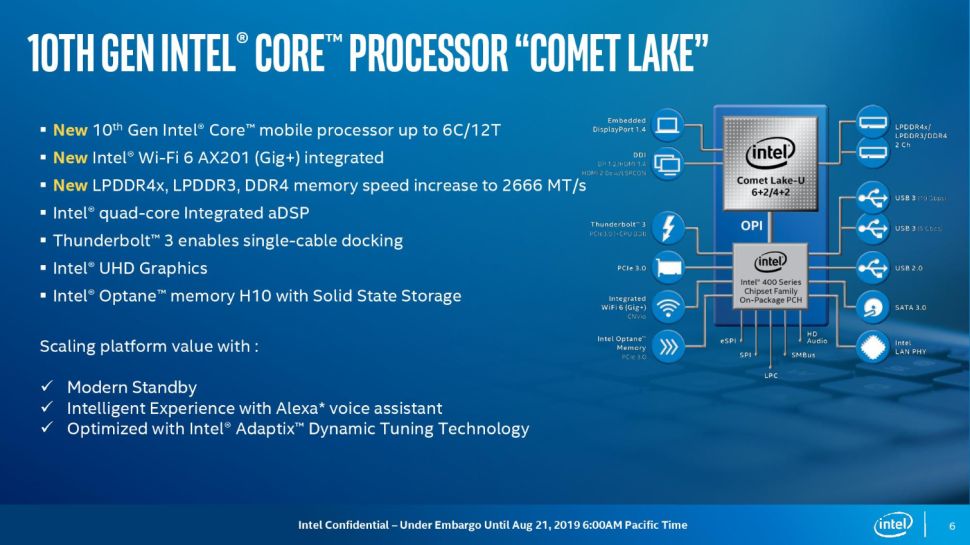Intel announced eight new Comet Lake processors for the mobile market. These new processors come in U- and Y-Series models for laptops and 2-in-1 designs and slot into the 10th Generation Core series, bumping up the U-series from four to six cores and the Y-series from two cores to four. The U-series models also add support for LPDDR4X. We also have coverage of the new Dell XPS 13 models and MSI’s content creation laptops, so head there for a look at the newest laptops with Comet Lake chips.
Unlike the 10nm Ice Lake chips the Intel began shipping earlier this month, the eight new models come wielding the 14nm process. That creates a confusing mismatch in the company’s 10th-Gen series, as the 10nm Ice Lake models come with a newer manufacturing process, architecture, and beefed up Gen11 graphics, while the 14nm Comet Lake chips come with the aging Skylake architecture and Gen 9.5 graphics. And they’re all lumped under the 10th-Generation branding.
The approach of mixing processes and microarchitectures under a single “Gen” family isn’t entirely new for Intel. The company began the practice with its 9th-Gen chips as it dealt with the fallout of its oft-delayed 10nm process, and has likely decided to continue shipping 14nm processors to assure enough supply of new laptop chips as it continues to ramp up 10nm production.
The tactic is beyond confusing to casual users: Most mainstream users aren’t aware of the finer-grained details of processor technology, so without a very clear product naming convention it would be easy to end up with 10th-Gen processors that don’t come with the expected amount of performance. Intel has revamped its naming scheme, which we’ll cover shortly, but it hardly helps.
Intel’s rationale is that the Ice Lake processors are better suited for light use-cases, like gaming, web browsing and office use, while the Comet Lake processors are better suited for productivity workloads that typically need more threaded horsepower, like multi-tasking and video/photo editing. Comet Lake’s higher core counts deliver more performance in those types of workloads.
The Ice Lake chips have a more efficient microarchitecture and 10nm process, so laptops with the chips will have better battery life. Ice Lake chips also have radically improved Gen11 graphics that offer nearly twice the performance of the older Gen 9.5 graphics found in Comet Lake. Gamers should definitely opt for Ice Lake models.
Intel divides the chips into the standard Core i3, i5, and i7 segments, but while the Ice Lake processors top out at four cores and eight threads, the Comet Lake chips stretch up to six cores and 12 threads. Comet Lake processors also come with higher peak boost frequencies that range up to 4.9 GHz, while Ice Lake tops out at 4.1 GHz. That, again, is going to lead to confusion, as the improved Ice Lake architecture is faster in lightly-threaded work despite its lower clock frequencies. In a similar vein, the Comet Lake processors have up to 12MB of L3 cache, but that comes as a byproduct of the higher core counts and doesn’t equate to faster performance than the Ice Lake models.
In a bid to “simplify” the difference between the two types of processors, Intel points to the “G7” branding (which could also be G4) that denotes the level of Gen11 graphics, as the primary identifier for Ice Lake chips. That makes sense, as the Comet Lake chips don’t come with Gen11 graphics and therefore do not have the “Gx” identifier, but that hardly helps the average consumer.
Conversely, Comet Lake with have a “U” or “Y” identifier at the end of its product string, whereas Ice Lake models will not. In other words, Intel is using its confusing change of product identifiers with the Ice Lake chips (here is a deeper look at what this mismash of numbers means) to help customers identify the difference between the chips.
Intel split up the Comet Lake series into U-Series Core i5 models with 15 and 25W TDPs, and Y-Series Core i7 models with 4.5, 7, and 9W TDPs. OEMs can use Intel’s cTDP (configurable TDP) feature to tailor the chips for either higher or lower performance envelopes with the option of a cTDP increase to 25W for U-series parts. Y-series chips can move up to 9W, or down to 4.5/5.5W. Unfortunately, as per Intel’s standard policy, OEMs don’t have to disclose which cTDP values they use in laptops, so performance among the stack can be a moving and unclear target.
In yet another round of confusion, the Core i7 chips support faster LPDDR4X-2933 and DDR4-2666 memory than the previous-gen models, while the Core i5 models only support LPDDR3-2133. Support for LPDDR4X comes as the byproduct of a new memory controller on the U-series chips, meaning the company has spun a new die for the chips. This addition also bumps maximum memory support up from 16GB in a dual-channel configuration to 32GB and results in lower power consumption with ‘like’ memory capacities.
Both the Ice Lake and Comet Lake processors support Thunderbolt 3 and Wi-Fi 6 connectivity, with the latter coming to the Comet Lake series through targeted enhancements to the platform controller hub (PCH). A Wi-Fi 6 MAC is integrated on the chipset, but it still requires a PHY for operation, thus reducing costs and avoiding additional FCC requirements for the chipset. Intel offers its own CNVi module as the other half of the integrated solution. This combination provides up to gigabit speeds wirelessly to increase performance for applications that are sensitive to network latency, like gaming, and enable advanced traffic management features.
Comet Lake processors do deliver more performance than previous-generation models due to higher clock speeds and enhanced in-silicon security mitigations for the recent wave of security vulnerabilities. Intel shared some of its performance projections for the new processors, with claims of up to 16% more overall performance and 41% better productivity compared to the previous-gen U-series chips. The company also shared data that shows even more explosive gains compared to a five-year-old laptop, which is the typical amount of time consumers use a laptop before splurging for a new model.
Intel also says that “some” 10th-Gen models will come with Dynamic Tuning Technology that uses pre-trained AI algorithms to predictively adapt based on usage patterns, but that is a feature of the Ice Lake processors, so Comet Lake users will not get the feature.
Intel says that more than 90 new laptop designs with the Comet Lake processors will hit shelves at retailers by the holidays.
